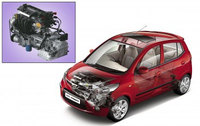Hyundai’s new Kappa engine
 In an era of soaring fuel prices, Hyundai is helping frugal-minded drivers with its newly developed Kappa engine.
In an era of soaring fuel prices, Hyundai is helping frugal-minded drivers with its newly developed Kappa engine."The world is thinking small like never before: smaller fuel consumption, smaller CO2 footprint, smaller overall emissions. Today small is beautiful and Hyundai is ready to answer the call to small with our new Kappa engine," said President and Chief Technology Officer Lee Hyun-Soon.
The first car to have the Kappa engine installed will be the i10 city car, with the first 1.2-litre engined i10s arriving in the UK in September.
Kappa is set to impress with its high specific torque rating of 9.6kg.m per litre – the best in class – for excellent drivability in stop-and-go city traffic. Kappa will also be installed in Hyundai's i20 due to be revealed at this autumn's Paris Auto Show.
Developed over a period of 48 months, the Kappa project harnessed all of Hyundai's engineering know-how in the quest to squeeze more energy out of each droplet of fuel while achieving EURO-4 emissions compliancy.
Kappa puts out 77.8ps@6000rpm - very competitive within the European A-segment -and peak torque is rated best-in-class at 12.0kg.m at 4000rpm - ensuring outstanding acceleration and driving enjoyment.
Kappa adopts a number of weight and friction reducing innovations to achieve its impressive fuel economy.
First, the engine block is made from high pressure die-cast aluminium which results in considerable weight savings: weighing a mere 82.4kg (with manual gearbox)—Kappa is the lightest in its class among leading European and Japanese-made engines.
Kappa’s main block features a ladder frame construction for superior structural stiffness while its cylinders are fitted with cast-iron liners for improved abrasion durability. Additional weight was shaved off by integrating the engine support bracket with the timing chain cover.
But probably the most significant engineering innovation is Kappa's offset crankshaft, an engineering concept first adopted in the Gamma engine introduced last year.
Unlike a conventional engine where the centreline of the cylinder bore is in perfect vertical alignment with the rotating axis of the crankshaft, the Kappa’s centreline is offset by a small distance. By creating this offset distance, engineers have succeeded in minimising the side force created by the pistons. The net effect is an improvement in fuel consumption and a reduction in noise, vibration and harshness.
Engineers also devised an innovative piston concept to reduce piston mass. The shape of the piston skirt was optimised to reduce its size while the compression height of the piston was also reduced, resulting in precious weight savings.
The optimised piston skirt is also treated with molybdenum disulfide (MoS2), a special anti-friction coating.
A highly sophisticated process of Physical Vapour Deposition (PVD) is used to apply an ultra-thin layer of chromium nitride (CrN) to the piston's oil ring. CrN ensures high wear resistance and a low friction coefficient. CrN-coated piston rings using PVD is an innovative technology borrowed from the Tau V8 engine that Hyundai introduced earlier this year.
Friction between the oil ring and cylinder wall has been further minimised by reducing the oil ring tension. The smaller mass and special surface treatment of the piston skirt and oil rings yielded additional savings in fuel consumption.
Kappa is the first Hyundai engine to be fitted with an accessory drive belt which does not require a mechanical auto-tensioning adjustment device, reducing the hardware and further lowering weight and cost. Because it is designed to maintain an ideal tension setting, the belt runs quieter and with proper preventative maintenance and care, the belt will last 100,000 miles.
Kappa uses a new, longer reach spark plug which enabled engineers to enlarge the size of the water jacket to promote more efficient engine cooling around the critically important spark plug and exhaust port area. Cooler operation also prevents engine knocking.
The long reach spark plug (M12 thread) also enabled engineers to enlarge the valve diameter for increased airflow and combustion efficiency.
Kappa’s valvetrain features a number of innovations: roller swing arm lowers friction in the valvetrain thereby helping improve fuel efficiency. Hydraulic lash adjusters ensure clearances between the valve stem and roller swing arm are always perfect: zero, eliminating valve tapping noise.
A new valve spring features an innovative beehive shape and smaller retainer. Its reduced weight and spring load help lower friction and improve fuel economy.
Kappa's valvetrain is driven by a silent-type steel timing chain that replaces a roller-type timing chain: the optimised design greatly reduces impact forces and noise when the gear tooth and chain engage. Moreover, the chain requires absolutely no maintenance.
A lightweight, heat-resistant engineering plastic was specified for the intake manifold. This reduces cost and weight and yields an overall performance improvement.
The fuel delivery pipe assembly is a returnless type (to eliminate evaporative fuel emissions) and is made of SUS (steel use stainless) with an innovative inner structure for the reduction of pulsation noise.
Kappa is controlled by two 16-bit 32Mhz microprocessors for digitally precise control of the ignition timing, idle speed, knocking and emissions.

